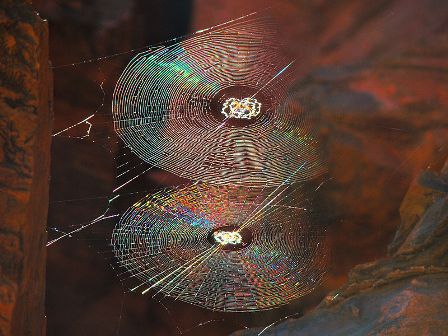- Series:Animals, Transcript English
Deuteronomy 12:30
“Take heed to thyself that thou be not snared by following them, after that they be destroyed from before thee; and that thou inquire not after their gods, saying, How did these nations serve their gods? even so will I do likewise.”
Spider webs can be beautiful things, although most people find spiders to be creepy and dislike them. Some spiders can give nasty bites and some are even deadly, showing us that danger often lurks with beauty.
 Caterpillars, centipedes, worms and scorpions all make silk, but spiders are the only species that depend on silk for catching their prey. Depending on the species, spiders have up to seven silk-making glands that produce a large number of different kinds of silk for different purposes. Silk from one gland may be used to wrap prey, while silk from another gland may be used to spin scaffolding. The female spider even has a special silk she uses for covering her eggs. The silk flows to the spinnerets out of each gland as a liquid. These organs, on the rear part of the spider’s abdomen, are movable and have nozzles at the end. The nozzles on the spinnerets can be used alone or combined in order to make a blend of different silks.
Caterpillars, centipedes, worms and scorpions all make silk, but spiders are the only species that depend on silk for catching their prey. Depending on the species, spiders have up to seven silk-making glands that produce a large number of different kinds of silk for different purposes. Silk from one gland may be used to wrap prey, while silk from another gland may be used to spin scaffolding. The female spider even has a special silk she uses for covering her eggs. The silk flows to the spinnerets out of each gland as a liquid. These organs, on the rear part of the spider’s abdomen, are movable and have nozzles at the end. The nozzles on the spinnerets can be used alone or combined in order to make a blend of different silks.
The spider then draws the silk from the spinneret. The faster the spider draws the silk, the thinner and stronger it is. As you can see, the spider has been given a lot of versatility in making silk.
God’s people know that danger often lurks with beauty, but we have a Savior and in Him there is forgiveness!
Prayer:
Dear Lord Jesus Christ, I thank You that You have overcome sin, death and the devil in my place. I pray with the disciples: Lord, I believe, help my unbelief, which the devil uses to snare me with attractive lures. Amen.
Notes:
Jo Ellen Tuthill. “Spider Webbing.” Science 82, pp. 100-102. Photo: Spiral orb webs. Courtesy of Bjørn Christian Tørrissen. Licensed under the Creative Commons Attribution-Share Alike 3.0 Unported license.
